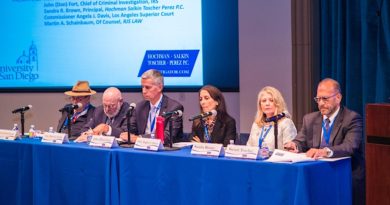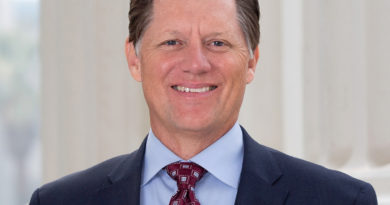Out of gas? Lost? Flat tire? Who ya gonna call?
5-1-1
It’s late at night and you‘ve just had a blow-out on the I-15 north of Escondido. You pull to the side of the highway, catch your breath, turn on your hazard lights, and wonder how far it is to the nearest call box. Oh, and did we mention it’s raining?
Stay seated. Today, San Diegans can just whip out their cell phones and dial 5-1-1 and rest assured that help for non-emergency roadside assistance will soon be on its way. Calls made via 5-1-1 on a cell phone are connected to the same call center that services stationery freeway call boxes.
Through the San Diego Service Authority for Freeway Emergencies (SAFE) Mobile Call Box program, motorists in need of a tow truck, gasoline or other types of aid, including any call transfers to the California Highway Patrol, AAA, or a manufacturer help line, can simply place a cell phone call. The program is particularly beneficial to disabled or elderly drivers who may experience difficulties accessing a fixed call box on the freeway. Motorists are still instructed to call 9-1-1 to report accidents, crimes, fires or other emergencies.
The free phone and Web service also consolidates the San Diego region’s transportation information into a one-stop resource. The new Website offers a number of features for commuters, transit riders, carpoolers, and visitors at www.511sd.com. The site provides up-to-the minute information on traffic conditions, incidents and driving times, schedule, route and fare information for San Diego public transportation services, carpool and vanpool referrals, bicycling information and more. It’s available 24 hours a day, seven days a week.
While the cellular service was actually introduced in February 2007, in conjunction with the San Diego Association of Governments’ (SANDAG) 5-1-1 Advanced Traveler Information System (ATIS) program, San Diegans’ awareness of the system is still on the upswing. About 10 percent of calls made to the call centers two months after the program’s introduction arrived via cell phone; now, approaching the three-year mark, the percentage has risen to about 30 percent.
Eddie Castoria, executive director of the callbox program, says that San Diego County is one of the first areas of the state to implement 5-1-1, a number that has been reserved for transportation information across the nation. The 5-1-1 system is available to more than 128 million Americans operating in 34 states and almost 1 million Canadians in the provinces of Nova Scotia and Yukon.
The SAFE program, says Castoria, is its own little entity. “It’s not under the jurisdiction of the state, or the city or the county, but was created through state legislation,” Castoria explains. The board is composed of seven elected officials; Ann Kulchin, a member of the Carlsbad City Council is chairwoman; Hal Ryan, council member of the city of Santee, is vice chair and directors include supervisors Ron Roberts and Bill Horn, city of Imperial Beach council member Diane Rose and city of San Diego council members Carl DeMiao and Sherry Lightner.
“As a long-time member of the San Diego SAFE Call Box Board of Directors, I am proud to have supported the Mobile Call Box Program from its start in 2007,” said Roberts. “We now provide drivers throughout San Diego County with two great ways to ask for help on our freeways and state routes. Motorists can use one of our roadside call boxes or make a cell phone call to 5-1-1 and ask for roadside assistance. The SAFE Mobile Call Box Program, in conjunction with SANDAG’s 5-1-1 program, provides an integrated motorist aid service that has become a model for other programs around the country. Most importantly, the SAFE Mobile Call Box Program and 5-1-1 have directly enhanced the safety of San Diego motorists and the overall efficiency of San Diego County highways.”
Castoria’s firm, TeleTran Tek Services Inc., was awarded the contract for management of the SAFE Call Box Program, when San Diego SAFE privatized management of the program in 1998. In the first year, the cost of call answering was reduced by 50 percent, a cost reduction from approximately $500,000 to $250,000, with costs continuing to go down. SAFE had to pay the California Highway Patrol higher rates, Castoria said, because non-emergency calls were handled by operators also dealing with emergency situations, which also resulted in longer wait times. Privatization resulted in a decrease of the average wait time for calls to be answered from two minutes to 15 seconds (roughly three rings).
Now San Diego’s Call Box program has become the model for other areas of the state planning to implement a cell phone program, most notably Los Angeles and surrounding counties.
But Castoria, who has worked in motorist aid functions since 1998, isn’t resting on the statistics. Now SAFE, in conjunction with the Intelligent Transportation Society of America (ITS America), is working on the “Motorist Aid of the Future” initiative.
For the near future, fixed call boxes will still be available, but Castoria acknowledges there are fewer of them dotting the highways than there were a few years ago. From a high of 1,770 in 2005, 370 of the call boxes have been removed, leaving 1,400 on the sides of freeways and state routes such as SR 163, 78 and 94. “We went from a half mile to a mile spacing in urban areas, where there’s much more help available now,” Castoria said, noting such services as the Freeway Service Patrol (FSP) also operated by SANDAG, that gives free tows off the freeway or provides a free gallon of gasoline for motorists whose tanks have run dry. “We want to get disabled cars off the road for congestion management,” Castoria said. “If there is a car on the side of the road for any reason, traffic slows to a crawl.”
Since the late 1980s all fixed call boxes have operated on cellular networks and predated today’s green revolution, by being solar powered. There’s a reason that cellular technology was adapted early on for call boxes, said Castoria. “You and I don’t even want to think about what it would cost to trench telephone lines along the freeway,” he said.
With advances in solar technology and a move from analog to digital cellular, stationary call boxes cost less to run than they did 11 years ago, said Castoria. But the fixed boxes, which have also been retrofitted in compliance with the Americans with Disabilities Act, including the installation of TTY keyboards for hearing impaired individuals, still provide a needed service. Many people don’t have cell phones and in certain areas the call boxes, outfitted with directional antennae, provide better reception than standard cell phones.
Castoria does see a day when freeway call boxes will go the way of pay phones, which have all but disappeared from the landscape. “But that’s down the road quite a way,” he said. “There’s certainly that possibility, but only when new technologies come along.”
For now, SAFE wants to spread awareness of the 5-1-1 program and has materials to offer employers and chambers of commerce. According to BERKMAN, the public relations and marketing agency for the SAFE program, employers can contact info@berkmanpr.com for brochures, postcards, posters or copy to go into company newsletters to help spread the word. Already, Sharp HealthCare, UCSD, Cox Communications and Kyocera have joined in the outreach efforts.
In the meantime, Castoria finds the job of operating a motorists’ assistance program quite satisfying. “I think it would be a fair statement to say that I love my job,” he admits. “How many jobs are there where you go home at the end of the day and you can say that 300 people got helped by you? That’s what we do, my staff and my board, we help people.” z



